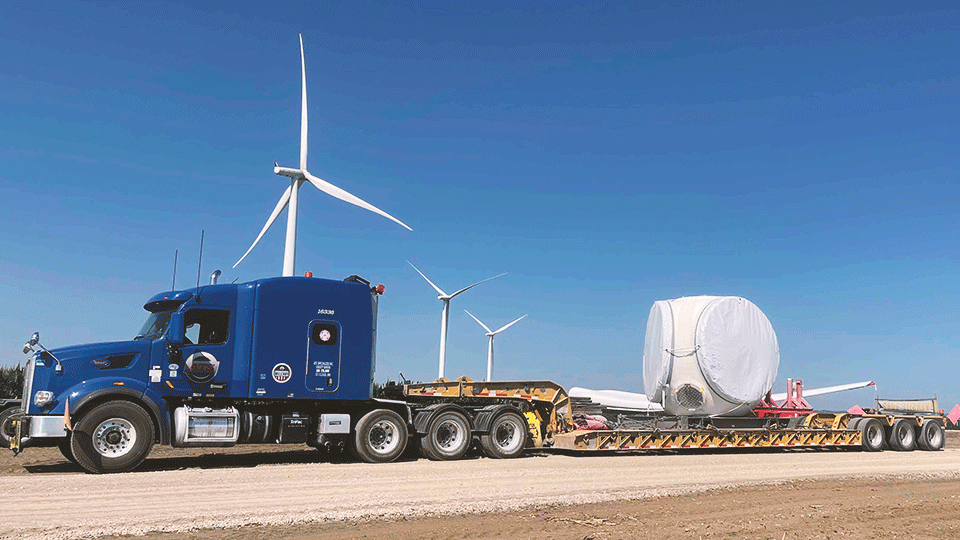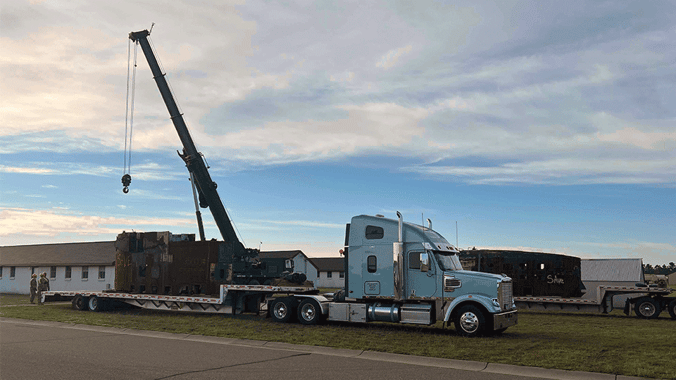
Even for the most experienced supply chain professionals, arranging and overseeing project logistics can be a massive undertaking. Regardless of its size, every project has tight timelines, multiple stakeholders to coordinate with and a budget to uphold.
Without proper planning and coordination, projects can become unnecessarily expensive — with pickups and deliveries facing delays or, in the worst cases, failure.
As a person who contributes to the execution of your company’s outbound shipping projects, you understand what’s at stake; customers are depending on you and offloading crews are waiting.
The success of your projects hinges on seamless coordination between your loading/shipping staff, your consignee’s offloading crews and the transportation providers you use.
Too often, shippers see their projects stall because of miscommunication and/or a lapse in planning. Use this planning guide to prevent mishaps on your next project.
Here at Anderson Trucking Service (ATS), our project teams have been helping companies across industries (from wind energy and solar power to construction and breakbulk) manage complex freight projects for decades.
In this article, we’ve listed the most impactful things you can do to ensure the smooth and efficient pickup and delivery of your project cargoes. Below, you’ll receive:
- 5 tips for on-time, smooth and efficient project pickups
- 6 tips for on-time, smooth and efficient project deliveries
At its conclusion, this guide will also give you some tips for choosing your next project carrier.
5 Tips For On-Time, Smooth and Efficient Project Pickups
- Provide accurate and detailed load information upfront
- Ensure your transportation provider understands the project’s scope
- Give your transportation provider an accurate pickup schedule
- Ensure your transportation provider can contact onsite personnel
- Relay permitting requirements well in advance (where applicable)
Making these things a priority will help you avoid delays and keep your projects on track, no matter how complex your freight moves are.
1. Provide Accurate and Detailed Load Information Upfront
Connecting your freight with its best-fit transportation solution isn’t always easy. To do so, your transportation provider needs to understand exactly what your freight is.
This is where you come in. . .
Make sure to provide an in-depth breakdown of the freight your carrier will be moving. This breakdown should list the specifics of all cargo, including:
- Overall cargo dimensions
- Overall freight height
- Total freight length
- Total freight width
- Total pallet count and size (where applicable)
- Overall load weight
- Detailed commodity description with pictures, when possible
- Additional cargo specifications
- Hazmat, liquids, sharp edges, cargo value, etc.
- Special securement instructions and plan (where applicable)
During your initial conversations with carriers, it’s also helpful to include information regarding the onsite loading capabilities at each pickup location and (if you have any) preferred/recommended trailer types.
With these details, your transportation provider will be far more comfortable connecting your freight with its perfect solution(s). This will also cut down on issues that arise when a driver arrives at a pickup without knowing exactly what they’ll be hauling.
2. Ensure Your Transportation Provider Understands the Project’s Scope
The “scope” of your project means several things, including:
- Target start date (first load pickup)
- Target end date (final load delivery)
- The estimated volume of shipments picking up per day
- The estimated volume of shipments delivering per day
- The number of transportation companies hauling for you
- Details about each lane your project will cover
- Distances, road types, etc.
- Deadlines, timelines and any appointment requirements
Understanding each of these details will help your transportation provider ensure on-time pickups/deliveries and quote your rates accurately.
Without knowing what’s expected of them, what other parties are involved (who they may need to coordinate with), for how long they’ll be servicing your project and which origins they’ll need to send trucks to, a carrier’s job gets much harder.
So, to make sure your loads pick up on time, clearly outline the scope of your project with each carrier.
Related: 7 Keys For Receiving Competitive and Effective Project Quotes
3. Give Your Transportation Provider an Accurate Pickup Schedule
Providing an accurate pickup schedule, to the best of your knowledge, is very important when arranging transportation services for your project loads. With this schedule in hand, your provider can begin arranging trucks to meet each deadline.
When it comes to your project pickups, there’s no such thing as too much lead time; it’s helpful for carriers to know what’s coming up, well into the future.
If pickup scheduling changes during the project, you’ll want to give each carrier an adjusted schedule with the most up-to-date details.
4. Ensure Your Transportation Provider Can Contact Onsite Personnel
The more lines of communication that are open throughout your project, the better executed it will be. Everyone should have everyone else’s contact information.
A huge part of this is ensuring your transportation companies have the correct phone number and email address for the relevant personnel at each freight origin.

With this information, these parties can communicate about adjusted loading schedules, inbound trucks and when a delay (on either side) is likely. Too often, issues arise when a carrier can’t reach the correct contact at a project’s origin (or vice versa).
To avoid these problems entirely, make sure to relay all relevant contact information to your transportation company.
5. Relay Permitting Requirements Well in Advance (Where Applicable)
Over-dimensional (OD) permits will be required to transport any of your project loads exceeding the legal limits for height, weight, length or width. Without the proper permits and permissions, this freight can’t be transported.
The turn time for OD permits will vary substantially from one situation to the next.
However, if your project has strict timelines to uphold (as most do) you’ll want to secure permits days before your target “go” date.
Although great transportation companies have in-house permitting teams dedicated to getting customer permits efficiently, a bit of warning here is always appreciated. In fact, of the common problems that arise on permitted project loads, most of them are solved with proper lead time.
So, make sure to highlight any shipments that are over-dimensional and work through this with your carriers. Doing so will ensure your freight can legally be picked up on time.
Related: The Pros and Cons of Adding a New Transportation Provider Mid-Cycle
6 Tips For On-Time, Smooth and Efficient Project Deliveries
- Make sure the project site has an accurate delivery schedule
- Relay onsite crane and crew information to your transportation provider
- Verify whether special credentials are required at the delivery site
- Give your transportation provider detailed site information and delivery instructions
- Make sure consignees accurately notate every bill of lading
- Ensure your provider has accurate contact details for onsite personnel
1. Make Sure the Project Site Has an Accurate Delivery Schedule
Just like a pickup schedule helps your carrier stay on the same page as your origin’s shipping personnel, connecting your consignee with an accurate delivery schedule ensures a smooth experience for everyone.
Whenever a truck shows up at a location and the people on site are surprised, problems occur. As such, it’s important (to the best of your ability) you develop a schedule forecasting when trucks are expected to arrive and what will be on each of them. Give this schedule to your receivers so they can plan accordingly.
2. Relay Onsite Crane and Crew Information To Your Transportation Provider
With project deliveries, too much money is wasted paying crane and labor crews overtime, waiting for a truck to arrive. As you’re probably aware, this can get expensive quickly.

Reliable carriers will have a plan in place for meeting the delivery windows you’ve set for them. That said, knowing when and for how long cranes and crews will be on site gives them a better understanding of what’s waiting for each driver upon delivery.
And, planning with these timetables in mind helps carriers further coordinate their trucks, ensuring crews aren’t left in the lurch.
3. Verify Whether Special Credentials Are Required at the Delivery Site
Sometimes, truck drivers are required to have special credentials in hand to access a delivery location. Whether this is just paperwork verifying their connection to your project, a special badge or some kind of certification, if your delivery site has these requirements, your carrier has to know.
Too often, significant delays occur when a truck driver isn’t granted admittance to a delivery site due to missing credentials. It’s not uncommon for this to happen right under a shipper’s nose — when they didn’t even know credentials would be required.
As such, you must check with each delivery location to ensure this won’t be an issue. And, if a set of credentials will be required, make sure your carrier is properly equipped.
4. Give Your Transportation Provider Detailed Site Information and Delivery Instructions
Getting to and navigating a delivery location can be challenging for drivers that have never been there before. That’s why it’s helpful to have a set of directions to follow (as they approach your location) and details on what to expect when they arrive.
Often, without knowing information like which side of the site to enter, where to park and what kind of terrain they’ll need to maneuver, drivers are more hesitant to make deliveries.
So, to ensure your projects run smoothly, connect your carries with a robust set of delivery instructions and site details — pictures and maps are also helpful to include here.
5. Make Sure Consignees Properly Notate Every Bill of Lading
With so many moving pieces, your projects may get overwhelming. That said, protecting your project cargo — ensuring it arrives in the same condition it left your door in — is a joint effort. Sure, your carrier’s trucks must properly handle and secure every load. But, other parties also play a role here.

Too frequently, shippers run into issues on their projects when a shipment arrives damaged or over/short in total quantity. That said, if that load’s consignee signs off on its bill of lading, marking it “clean” instead of sighting this issue, fixing these problems and receiving compensation is always an uphill battle.
As such, make sure your consignee(s) understand the role they play in cargo safety. Tell them exactly what’s supposed to be on every arriving truck and communicate your expectations should a shipment show up damaged/off in quantity.
6. Ensure Your Provider Has Accurate Contact Details For Onsite Personnel
It’s important to give your carrier the contact information of personnel at each project origin location. It’s equally vital for them to have this information on the delivery side.
With these contact details, your carrier can reach out to onsite personnel in advance of each delivery to flush out details like estimated arrival times, where they’d like them to park, whether they’re ready to unload right away, etc.
Making sure every stakeholder (on both the pickup and delivery side) has the phone number and email address of everyone else will pay dividends for your project. The last thing you want to deal with is unnecessary confusion and frustration because one party can’t reach the other.
As such, make sure to facilitate this connection to the best of your ability.
Make Sure Your Project Carrier is Up to Par
With these 11 tips in play, you should have no trouble keeping your next project on track. At the center of all of these tips, though, are the carriers you use. Transportation providers are an essential piece of your projects. And, there’s no reason why you shouldn’t work together to put these tips into action.
At the end of the day, poor carriers do exist. That’s why you need to be careful when building out your transportation network — especially when planning out a project.
But what should you think about when choosing your next carrier? What questions should you ask? And, perhaps most importantly, what qualities should you avoid entirely?
Use this Freight Carrier Selection Checklist to answer these questions and pick the best-fit transportation provider for your business. Download it for free today and ensure every project carrier you use is “checking all the boxes.”
Finally, if you would like to learn more about ATS’ project logistics services and how we can help you keep your next one on track, contact us today. One of our transportation professionals is ready and waiting to help you in any way you need.




